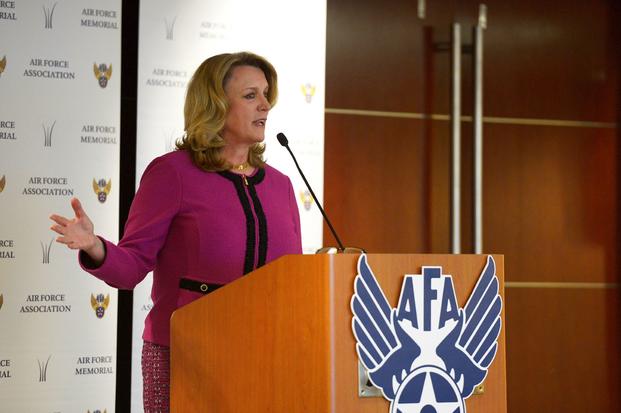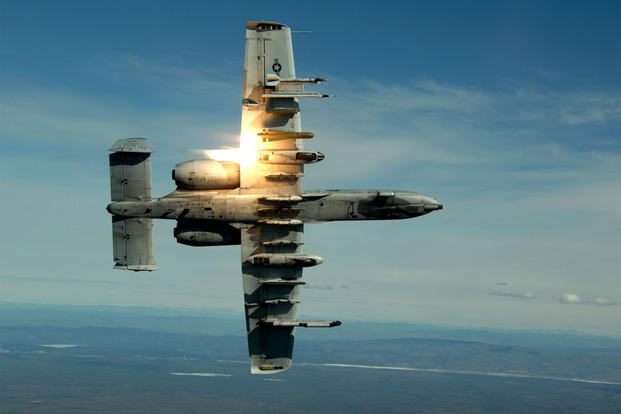For some U.S. Air Force leaders, retiring the A-10 Warthog close-air support aircraft was a simple decision.
Like many of the service's aircraft, the A-10, best known for its iconic Gatling gun designed to shred tanks, was wearing out in 2014 after years of providing cover for ground troops in places like Afghanistan and Iraq. So the service devised a plan to begin phasing it out in 2015.
Retiring the A-10 would have lowered the average age of the service's plane inventory, which was climbing toward 27 years. It would also have freed up funds to invest in new aviation platforms, such as the F-35A Joint Strike Fighter, and allowed service maintainers to turn their attention to other planes with a longer expected service life.
But the seemingly logical proposal launched a years-long firestorm when lawmakers, led by former Air Force Col. Martha McSally, rushed to save the beloved plane from mothballs. Years later, the fleet is being refurbished with new wings instead of being sent to the boneyard.
The dramatic A-10 turnaround illustrates how Air Force plans can fail to survive first contact with a Congress with other ideas. And, former officials and experts who spoke with Military.com said, that may be about to happen again.
Related: Air Force to Send More than 100 Planes to Boneyard as it Invests in Future Fighters
The Defense Department's fiscal 2021 budget request calls for the retirement of more than 100 aircraft across a number of platforms, including B-1B Lancer bombers; older-model KC-135 Stratotanker and KC-10 Extender refuelers; RQ-4 Global Hawk drones; and more than three dozen A-10s.
That would free up some $4.1 billion over the next five years to spend on future technologies and networking the existing fleet to make it more agile and capable. If, that is, Air Force leaders can somehow sell the plan to Congress.
"I feel like I've been to that movie before. And now this is going to be the sequel," said Deborah Lee James, the 23rd secretary of the Air Force. James, who spoke with Military.com this month, led the service between 2013 and 2017, during the A-10 fight.
"The question is, will the sequel have a different outcome? Different end to the story?" she said. "What I don't know is, if behind the scenes as they're preparing to retire aircraft from certain bases, do they have a backfill prepared to go in?"
The Trade-Offs
The Air Force isn't the only service asking Congress to let it dump old platforms.
The Navy failed to convince lawmakers last year that it should retire a carrier, the Harry S. Truman, halfway through its service life. The ship is now headed to the years-long midlife refueling process instead. Army and Marine Corps leaders are also talking about the need to ditch some legacy systems to pay for newer equipment they can use to fight Russia and China.
During the A-10 fight, McSally, an Arizona Republican who was then a U.S. Representative, was joined in her support of the platform by the late Sen. John McCain, also of Arizona; and then-Sen. Kelly Ayotte, whose husband, Joseph Daley, flew A-10s while in the Air National Guard.
With multiple aircraft platforms now facing at least partial retirement, the number of lawmakers with an interest in keeping the planes on the flightline could grow, the analyst said. Plus, it's not explicitly clear which -- and how many -- lawmakers might oppose the Air Force's plan.
"No member of Congress wants to lose, or stand by and silently lose, a fleet of aircraft or a capability from their state or district, which, of course, translates to jobs," James said.
"And just like a defense attorney or a prosecutor, a congressman or senator is going to make his case: to keep what they've got. And boy, it'll sound like, 'How in the world, Air Force, could you be so stupid?'" James said.

Another challenge is selling what the Air Force wants in place of its aging planes: next-generation systems of technology, such as the Advanced Battle Management System (ABMS), which isn't "iron on the ramp" -- a visible show of warfighting strength.
Air Force leaders want to spend more than $300 million -- more than double last year's enacted funding of $144 million -- on the new ABMS, a state-of-the-art program that focuses on fusing intelligence, surveillance and reconnaissance sensor data from around the globe. The service also has to fund ongoing buys of the F-35 Lightning II and KC-46 Pegasus tanker, as well as research, development, test and evaluation (RDT&E) spending for the upcoming B-21 Long Range Stealth bomber.
The more access lawmakers can get to the rationale behind the Air Force's tough choices, the more likely they may be to compromise, said Heather Wilson, the 24th secretary of the Air Force.
"Be accessible, try to be responsive," she said, adding that transparency matters.
"I understood the frustration of being a member of Congress where you have to wait an hour-and-a-half to ask five minutes of questions. You never get all the stuff you want answered, answered. It can be frustrating. So the best thing that the services can do is meet with those members in advance," she said.
When she arrived at the Pentagon just after James in 2017, Wilson found that, when lawmakers called, her staff would stick to protocols that dictated setting up a meeting, getting the correct documentation in order and observing other bureaucratic procedures.
"Just relax, folks," said Wilson, who served as a U.S. representative for New Mexico between 1998 and 2009. She resigned from her post and departed the Pentagon in May 2019 to take her new position as president of the University of Texas El Paso.
"The member is calling me. How about, if a member of Congress calls, put the call through?" she said in an interview Wednesday. "They know I may not know the answer. They may not [get] the answer they wanted to hear, but at least they deserve an answer."
No Surprises, Less Emotion
James said she now grasps why lawmakers got defensive about the A-10, though she didn't understand the passion surrounding it right away.
"I think the emotion associated with the A-10 did end up surprising a lot of people," she said. "Think about it: You drove whatever your first car was, and you probably don't still have that first car, but I was ready to go onto my next car after I'd had that first car for a certain amount of time.
"Now, I know a car is not a fighter aircraft, but still the emotion associated with the machine surprised me. ... I don't get emotional about equipment. I'm all for going for a better piece of equipment and doubling down on [advocating for] people [instead]."
Of course, more money helps. Military spending has risen each year for the last five years -- from $586 billion in 2015 to $716 billion in 2019, according to The Washington Post. The fiscal 2020 bill, passed in December, gives the military $738 billion. The Air Force makes up 24% of the overall defense budget, Wilson said.
But with the Pentagon and military services cutting billions in "night court" budget sessions, the Air Force still can't afford to get sentimental this time.
"There's been a lot more signaling; the Air Force wasn't allowed to say anything explicit, but Air Force leaders for a couple of months now have been going around warning that they were going to be trading existing systems for future systems -- that there were going to be some significant retirements proposed," said a longtime defense analyst in Washington, D.C.
Officials had been communicating that informally to Capitol Hill well ahead of the budget request, the analyst told Military.com.
"Congress does not react well to surprises."
The Last Successful Fleet Retirement
Aircraft retirement has never been an easy task, especially since the Air Force has much to choose from. It's a byproduct of the service's gilded age of procurement, which came right after the Vietnam War, said Brian Laslie, an Air Force historian who has written two books: "The Air Force Way of War" and "Architect of Air Power."
"[It stems] from the 'We'll never let that happen again' mindset," Laslie said, referencing the devastating losses in airpower over the course of the war, which saw more than 2,000 aircraft destroyed.
After those losses, the Air Force was able to increase its training funding and expedite funds for the F-15 Eagle, F-16 Fighting Falcon, A-10, KC-10 and F-117 Nighthawk, Laslie said.
So when the service's F-4 Phantom fighter-bomber fleet slowly began to wind down from manned operations following one of its last missions in Desert Storm in 1991, there was a natural backfill of aircraft to take its place, he said.
It may be the last successful retirement of a single, full fleet that the Air Force was able to accomplish, both the analyst and Laslie said.
Perhaps unintentionally, the F-117 became the face of Desert Storm. It then made it easy to pitch the service's next big endeavor: stealth technology.
"The Air Force treated the procurement of its desired force structure after Desert Storm like a roulette table in Las Vegas, and the Air Force bet it all on black," Laslie said. "Meaning, the Air Force put all their money into the concept of low-observable stealth technology, because that was the future of warfare."
As the F-117 -- and later the F-22 Raptor and B-2 Spirit bomber -- became flying demonstrators of stealth technology, lawmakers could appreciate their benefits.
ABMS -- and connected intelligence networks, or a "family of systems" overall -- will not be as easy to sell, argued the analyst.
The U.S. is "going to do something that isn't headquartered in a particular place, that doesn't employ maintainers in a particular place; it's a distributed system. That's a hard sell from a constituent point of view," the analyst said.
"But also, it's a hard sell from a concept point of view. ABMS is still unformed inside the Air Force -- there isn't the final picture of what it looks like," the analyst said. "Parts of it are going to wind up being classified, and it's inherently difficult to make a public argument for a classified system."
Pushing the Story
During her tenure as Air Force secretary, Wilson too was tasked with pitching new ideas, such as interconnected networks, data computing and artificial intelligence. She admitted being a former lawmaker did help her advance the dialogue between the Air Force and Congress, and said she took frequent trips to speak to members.
In one case, she was successful.

Wilson and Goldfein got lawmakers to think beyond the E-8C Joint Surveillance Target Attack Radar System aircraft, capable of developing, detecting, locating and tracking moving targets on the ground. Through the fiscal 2019 defense budget, the service officially put to bed the JSTARS recapitalization effort. Instead, the 2019 National Defense Authorization Act granted additional funding for the next-generation ABMS in lieu of a new fleet; as a compromise, the current fleet -- which dates back to the 1990s -- will stick around into the mid-2020s.
Like JSTARS, the other aircraft slated to be cut in the upcoming budget have already been pushed to their limit, hindering how effective they can be.
"It's not really the question of having equipment and using that old equipment," Wilson said.
"It's [about], 'Is it really worth what we're going to have to do to this over old equipment to keep it flying safely?'" she said.
That's also part of the Air Force story, she said. "And that story will be told in dozens and dozens of meetings over the coming months of what the choices were and what they're trying to accomplish."
-- Oriana Pawlyk can be reached at oriana.pawlyk@military.com. Follow her on Twitter at @Oriana0214.
Read more: Sikorsky-Boeing's SB-1 Defiant Helicopter Prototype Impresses Leaders in Flight Demo












